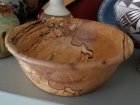Hello Folks,
I spent the last 25 years building custom cabinetry, finish carpentry and general remodeling work. A couple of years ago I purchased a 12" x 36" Grizzly lathe from a customer and have been anxious to dive into it. I'm new to wood turning and would love some insight as to techniques, stance, how to hold tools, adjust the tool rest and just about anything else that would help. I have been through a multitude of You Tube videos (too many) and really haven't picked up the basics. So far I've managed to turn a walnut mallet and a small spalted maple bowl out of my firewood pile. Since then I've purchased a Super-Nova 2 chuck bundle, a Wolverine sharpening system with the Vari-grind 2 and I've got several different chisels that I've picked up here and there. What a difference sharp chisels make!
I'm semi-retired and really want to get more involved in turning. Anyone have a suggestion as to where I can find some good basic starting points for turning techniques? I did just find a book online: 'A Course In Wood Turning' by Archie S. Milton and Otto K. Wohlers from 1919. I'm sure some techniques may have changed since then, but it may be worth a look. Looking forward to any suggestions.
I spent the last 25 years building custom cabinetry, finish carpentry and general remodeling work. A couple of years ago I purchased a 12" x 36" Grizzly lathe from a customer and have been anxious to dive into it. I'm new to wood turning and would love some insight as to techniques, stance, how to hold tools, adjust the tool rest and just about anything else that would help. I have been through a multitude of You Tube videos (too many) and really haven't picked up the basics. So far I've managed to turn a walnut mallet and a small spalted maple bowl out of my firewood pile. Since then I've purchased a Super-Nova 2 chuck bundle, a Wolverine sharpening system with the Vari-grind 2 and I've got several different chisels that I've picked up here and there. What a difference sharp chisels make!
I'm semi-retired and really want to get more involved in turning. Anyone have a suggestion as to where I can find some good basic starting points for turning techniques? I did just find a book online: 'A Course In Wood Turning' by Archie S. Milton and Otto K. Wohlers from 1919. I'm sure some techniques may have changed since then, but it may be worth a look. Looking forward to any suggestions.

